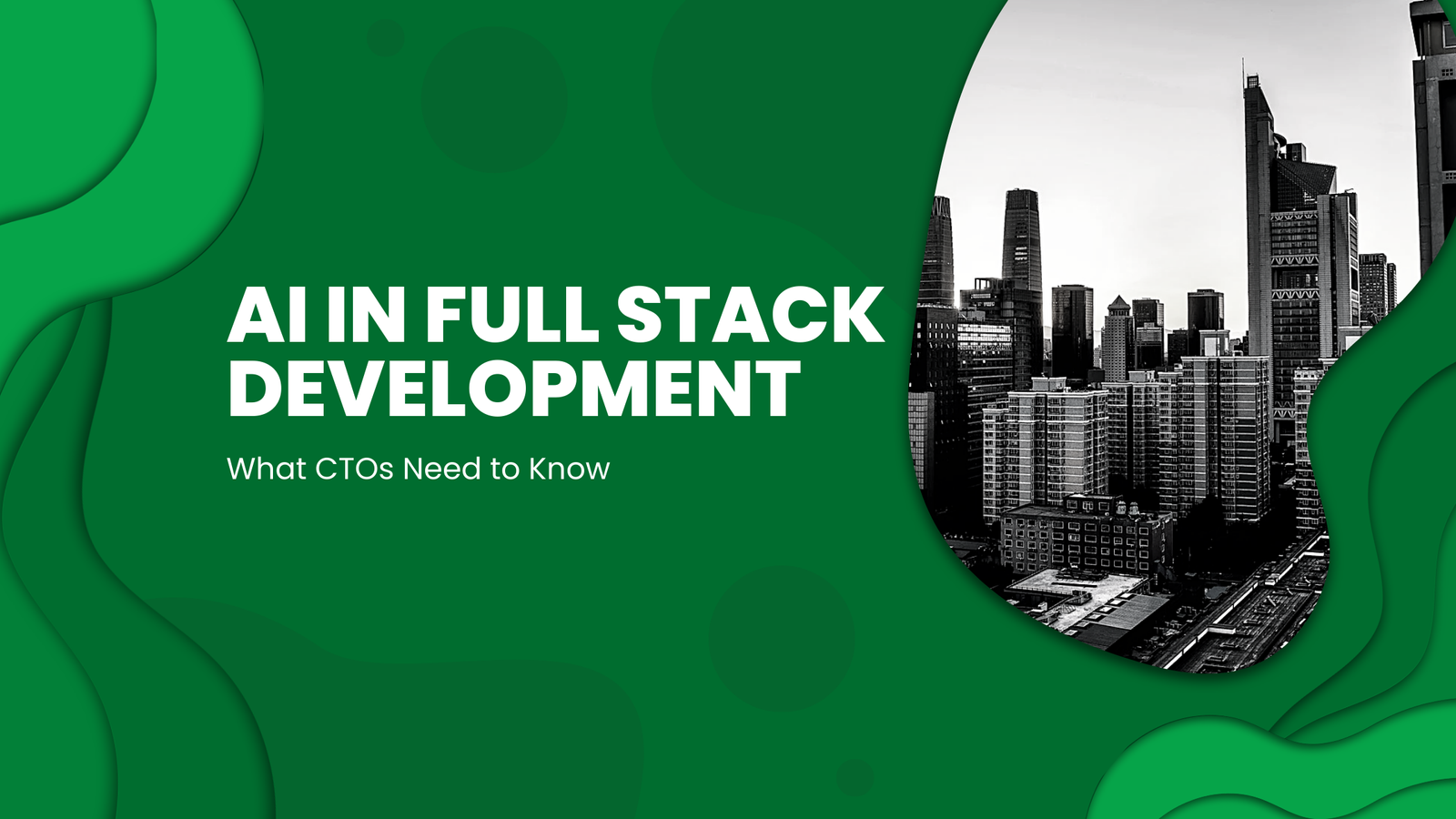In a world where technological boundaries are rapidly dissolving, the rules of software development are being rewritten. And if there’s one player at the center of this evolution, it’s artificial intelligence.
For CTOs, the rise of AI is not just another wave—it’s the tide itself. Full stack development, once a domain of code-wrangling wizards juggling front-end aesthetics with back-end logistics, is undergoing a radical transformation. AI is now deeply embedded in the workflow, not only accelerating processes but also redefining what it means to build, deploy, and maintain applications.
But how deep does this integration go? What’s myth, and what’s market-ready? This blog lays bare the real story of AI in full stack development—no fluff, just what you need to know.
The Evolution of Full Stack Development in the Age of AI
Let’s rewind for a moment. Traditionally, full stack development demanded broad skill sets: HTML, CSS, JavaScript, databases, server-side scripting, APIs—you name it. Developers were expected to be jacks-of-all-trades and masters of time. But that model came with a cost: slow development cycles, higher burnout rates, and the ever-looming challenge of keeping up with tech’s relentless pace.
Then came AI—not as a standalone innovation but as a force multiplier. From GitHub Copilot suggesting entire lines of code to AI-driven CI/CD tools managing deployment pipelines, full stack developers are getting smarter assistance at nearly every layer. It’s no longer about how much you can code—it’s about how intelligently you can orchestrate development.
AI hasn’t replaced developers. It’s redefined their role.
AI’s Growing Presence Across the Stack
Let’s break it down, layer by layer:
Front-End Intelligence:
AI-powered design tools like Figma’s auto-layout and Adobe Sensei reduce grunt work by anticipating layout needs and suggesting optimal UI flows. Then there’s personalization—AI engines now adapt front-end interfaces in real time based on user behavior, device type, even emotional sentiment detected via interaction data.
Back-End Reinforcement:
Here, AI handles predictive analytics, smart caching, and data flow optimization. Machine learning models predict server load and allocate resources dynamically. Developers are no longer hand-tuning servers; they’re tuning models that tune servers.
Database Management:
Modern applications generate heaps of data, and traditional query optimization just doesn’t cut it anymore. AI-assisted database engines analyze usage patterns to proactively index data, prefetch information, and optimize queries. Think of it as having a live-in data analyst baked into your infrastructure.
APIs and Integration:
AI simplifies integration by generating boilerplate code and validating third-party APIs for security or redundancy issues. Platforms like Postman and Swagger now use AI to auto-document APIs and even simulate calls, drastically reducing testing time.
Security:
From anomaly detection to automated threat modeling, AI is making full stack applications smarter and safer. It identifies suspicious patterns, quarantines vulnerabilities, and even writes patches—yes, actual code patches—on the fly.
In short, every brick in the full stack wall now has a bit of AI cement holding it in place.
What CTOs Must Consider Before Jumping on the AI Bandwagon
Now, before you sprint toward your procurement officer asking for “more AI,” let’s pause and calibrate. The promise is big—but the implementation is not without pitfalls.
1. Technical Debt Can Compound
AI introduces convenience, but at a price. Generated code, especially when not reviewed critically, can become a minefield of inefficiencies. If your developers treat AI suggestions as gospel, you’re courting technical debt that might come back to bite—hard.
2. Interpretability vs. Complexity
AI, particularly deep learning models, can be black boxes. Sure, it’s thrilling when your algorithm optimizes user retention, but do your developers understand how it did it? If not, debugging becomes guesswork. That’s dangerous, especially in mission-critical applications.
3. Vendor Lock-In
Many AI tools offer ease at the cost of freedom. You may end up tied to a specific ecosystem or cloud platform, and migrating later can be both technically and financially expensive.
4. Skills Gap Within Teams
Let’s face it: not all developers are AI-literate. Upskilling is a real need. Teams must understand model training, ethical AI principles, and algorithmic fairness. Without that, you’re just slapping automation onto your stack without actually controlling it.
CTOs must think like chess players—every AI implementation should serve a long-term architectural strategy, not just solve a short-term bottleneck.
Real-World Use Cases that Show AI’s Full Stack Influence
Sometimes the best way to understand impact is to see it in motion. So here are a few examples of companies doing it right:
1. Netflix
Their A/B testing infrastructure? AI-driven. Their recommendation engine? Fully stacked with ML. From front-end personalization to back-end load balancing, Netflix runs a tight AI-infused ship.
2. Shopify
The e-commerce giant uses AI for fraud detection, storefront customization, and even to help merchants write product descriptions. Their developer teams rely on AI to enhance API performance and reduce front-end latency.
3. Airbnb
With dynamic pricing algorithms and predictive search filters, Airbnb’s stack exemplifies AI’s integration across user interfaces, server orchestration, and database tuning.
These aren’t isolated cases—they’re signals of where the industry is headed.
How AI Is Reshaping Development Workflows
Development isn’t just about code. It’s about how code gets written, tested, reviewed, and deployed. AI is infiltrating each phase:
Code Generation:
With tools like GitHub Copilot and Amazon CodeWhisperer, AI offers intelligent code suggestions in real-time. These aren’t autocomplete gimmicks—they write entire functions based on comments.
Testing:
AI tests your code even before you do. It suggests test cases, identifies edge cases, and sometimes auto-generates regression suites. This tightens feedback loops and brings QA closer to dev cycles.
Deployment Pipelines:
CI/CD is now smart. Tools use AI to predict failed builds, flag suspicious changes, and even recommend rollback points. It’s DevOps, but with eyes and ears.
Monitoring and Observability:
AIOps platforms digest logs, monitor performance, and detect anomalies. Instead of reacting to crashes, you’re alerted before they even occur. The paradigm shifts from firefighting to foresight.
That said, AI doesn’t replace the need for solid architectural judgment. It’s a co-pilot—not the aircraft.
Balancing Control and Automation: The CTO’s Dilemma
Here’s the crux: how much control should you give away? AI’s promise is seductive—it does the heavy lifting, makes teams more efficient, reduces time-to-market. But full automation is a slippery slope.
Automated doesn’t mean optimized. AI might make something work, but that doesn’t mean it’s scalable, secure, or strategic.
Don’t treat AI outputs as final. They’re starting points. Encourage your team to challenge AI-generated code, not just copy-paste it into prod.
Introduce review loops. Every AI interaction should feed back into the system: Was the suggestion useful? Was the performance gain real? This helps AI get better, but more importantly, it keeps humans in the driver’s seat.
The best CTOs foster teams that collaborate with AI, not under it.
The Ethical and Regulatory Front You Can’t Ignore
Let’s address the elephant in the server room: AI isn’t just a technical leap. It’s a legal and ethical minefield. And CTOs are squarely in the blast zone.
Data Privacy:
If your AI tools train on user data, are they compliant with GDPR? With CCPA? Where is your training data stored, and who has access?
Bias in Algorithms:
A model might seem “efficient” until it starts discriminating. Whether it’s in search rankings or user segmentation, unchecked bias can damage brand equity and expose you legally.
Audit Trails:
Can you explain why your AI made a certain decision? Regulators are starting to ask, and you’ll need more than “because the algorithm said so.”
Open Source Risks:
Many AI tools rely on open-source models. That’s great for transparency, but risky if vulnerabilities aren’t managed. A single dependency flaw can cascade across your stack.
Proactive governance isn’t optional anymore—it’s your firewall against chaos.
The Strategic Edge: Why Smart CTOs Are Betting on AI Now
You might be wondering—why all this urgency? Why should you adapt now, not later?
Because late adopters won’t just lag; they’ll lose. AI is not a trend. It’s an infrastructure shift. Here’s why it matters today:
1. Competitive Velocity:
AI compresses product timelines. What once took quarters now takes weeks. Companies leveraging AI move faster, ship faster, and learn faster.
2. Developer Experience:
Retention matters. Developers who work with intelligent tools are less burned out and more productive. That means lower attrition and better morale.
3. Innovation Leverage:
With AI automating repetitive tasks, dev teams are free to explore bold features, deeper integrations, and richer user experiences.
4. Business Alignment:
AI’s predictive capabilities improve customer insight, reduce downtime, and unlock new monetization models. It connects technical output with business outcomes.
It’s not about being first. It’s about being ready—and agile—when the market shifts again.
Conclusion: A New Kind of Stack, A New Kind of CTO
AI isn’t some shiny overlay you slap on your tech stack. It’s a foundational shift in how full stack development works, thinks, and scales. It demands that CTOs re-evaluate their talent strategies, tooling decisions, ethical stances, and even their definition of innovation.
It’s no longer enough to build software that works. The new benchmark is software that learns, adapts, and improves.
And that’s where the opportunity lies.
For organizations looking to stay relevant, resilient, and ready for the future, partnering with a trusted full stack development services company in US that understands both code and cognition isn’t just wise—it’s essential.
You’re not just leading a tech team anymore. You’re orchestrating an ecosystem.
And in that ecosystem, AI isn’t just a tool. It’s your competitive edge.











Leave a Reply